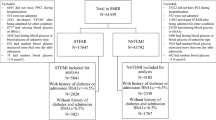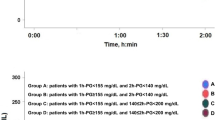Abstract
In the setting of acute myocardial infarction, hyperglycemia and acute insulin resistance may represent a stress response to myocardial injury mainly related to acute catecholamine release. By measuring glucose values and insulin resistance (Homeostatic Model Assessment index—HOMA), we evaluated in 356 non-diabetic patients with ST-elevation myocardial infarction (STEMI) undergone mechanical revascularization: (a) the acute glycometabolic response by evaluating insulin resistance, glucose levels, and their combination and (b) whether insulin resistance and increased glucose values (and their combination) are able to affect in-Intensive Cardiac Care Unit (ICCU) mortality and complications. In the overall population, 226 (63.5%) patients showed glucose values ≤140 mg/dl (group B), while 130 patients had glucose values >140 mg/dl (group A) (36.5%). Within group B, insulin resistance (as inferred by positive HOMA index) was present in 125 patients (55.3%), whereas 101 patients (44.7%) exhibited normal values of HOMA index. Within group A, 109 patients (83.8%) were insulin resistant, while 21 patients (16.2%) had normal values of HOMA index. At multivariable analysis, glucose values were independently associated with in-ICCU mortality (OR: 7.387; 95% CI 2.701–20.201; P < 0.001) and complications (OR: 1.786; 95% CI 1.089–2.928; P = 0.022). In the early phase of STEMI, the acute glycometabolic response to stress is heterogeneous (ranging from no insulin resistance to glucose levels >140 mg/dl and, finally, to the combination of increased glucose values and insulin resistance). Increased glucose values are stronger prognostic factors since they are independently associated with in-ICCU mortality and complications.
Similar content being viewed by others
References
Opie LH (2008) Metabolic management of acute myocardial infarction comes to the fore and extends beyond control of hyperglycemia. Circulation 117(17):2172–2177
Oswald GA, Smith CC, Betteridge DJ et al (1986) Determinants and importance of stress hyperglycaemia in non-diabetic patients with myocardial infarction. Br Med J (Clin Res Ed) 293(6552):917–922
Lazzeri C, Tarquini R, Giunta F, Gensini GF (2009) Glucose dysmetabolism and prognosis in critical illness. Intern Emerg Med 4(2):147–156
Deedwania P, Kosiborod M, Barrett E et al. (2008) American Heart Association Diabetes Committee of the Council on Nutrition, Physical Activity and Metabolism. Hyperglycemia and acute coronary syndrome: a scientific statement from the American Heart Association Diabetes Committee of the Council on Nutrition, Physical Activity, and Metabolism. Circulation 117(12):1610–1619
Kosiborod M, Rathore SS, Inzucchi SE (2005) Admission glucose and mortality in elderly patients hospitalized with acute myocardial infarction: implications for patients with and without recognized diabetes. Circulation 111(23):3078–3086
Kosiborod M, Inzucchi SE, Krumholz HM et al (2008) Glucometrics in patients hospitalized with acute myocardial infarction: defining the optimal outcomes-based measure of risk. Circulation 117(8):1018–1027
Kosiborod M, Inzucchi SE, Krumholz HM et al (2009) Glucose normalization and outcomes in patients with acute myocardial infarction. Arch Intern Med 169(5):438–446
Svensson AM, McGuire DK, Abrahamsson P, Dellborg M (2005) Association between hyper- and hypoglycaemia and 2 year all-cause mortality risk in diabetic patients with acute coronary events. Eur Heart J 26(13):1255–1261
Goyal A, Mahaffey KW, Garg J et al (2006) Prognostic significance of the change in glucose level in the first 24 h after acute myocardial infarction: results from the CARDINAL study. Eur Heart J 27(11):1289–1297
Suleiman M, Hammerman H, Boulos M et al (2005) Fasting glucose is an important independent risk factor for 30-day mortality in patients with acute myocardial infarction: a prospective study. Circulation 111(6):754–760
Lazzeri C, Chiostri M, Sori A, Valente S, Gensini GF (2010) Postprocedural hyperglycemia in ST elevation myocardial infarction submitted to percutaneous coronary intervention: a prognostic indicator and a marker of metabolic derangement. J Cardiovasc Med 11(1):7–13
Nishio K, Shigemitsu M, Kusuyama T, Fukui T, Kawamura K, Itoh S, Konno N, Katagiri T (2006) Insulin resistance in nondiabetic patients with acute myocardial infarction. Cardiovasc Revasc Med 7(2):54–60
Wallander M, Bartnik M, Efendic S (2005) Beta cell dysfunction in patients with acute myocardial infarction but without previously known type 2 diabetes: a report from the GAMI study. Diabetologia 48(11):2229–2235
Lazzeri C, Sori A, Chiostri M, Gensini GF, Valente S (2009) Prognostic role of insulin resistance as assessed by homeostatic model assessment index in the acute phase of myocardial infarction in nondiabetic patients submitted to percutaneous coronary intervention. Eur J Anaesthesiol 26(10):856–862
Saberi F, Heyland D, Lam M, Rapson D, Jeejeebhoy K (2008) Prevalence, incidence, and clinical resolution of insulin resistance in critically ill patients: an observational study. JPEN 32(3):227–235
Valente S, Lazzeri C, Chiostri M, Chiostri M, Giglioli C, Sori A, Tigli S, Gensini GF (2009) NT-proBNP on admission for early risk stratification in STEMI patients submitted to PCI. Relation with extension of STEMI and inflammatory markers. Int J Cardiol 132(1):84–89
Valente S, Lazzeri C, Saletti E, Chiostri M, Gensini GF (2008) Primary percutaneous coronary intervention in comatose survivors of cardiac arrest with ST-elevation acute myocardial infarction: a single-center experience in Florence. J Cardiovasc Med 9(11):1083–1087
Buiatti E, Barchielli A, Marchionni N et al (2003) Determinants of treatment strategies and survival in acute myocardial infarction: a population-based study in the Florence district, Italy: results of the acute myocardial infarction Florence registry (AMI-Florence). Eur Heart J 24(13):1195–1203
European Association for Percutaneous Cardiovascular Interventions, Wijns W, Kolh P, Danchin N et al (2010) Guidelines on myocardial revascularization: the task force on myocardial revascularization of the european society of cardiology (ESC) and the european association for cardio-thoracic surgery (EACTS). Eur Heart J 31(20):2501–2555
Van de Werf F, Bax J, Betriu A et al (2008) Management of acute myocardial infarction in patients presenting with persistent ST-segment elevation: the task force on the management of ST-segment elevation acute myocardial infarction of the European society of cardiology. Eur Heart J 29(23):2909–2945
Huggett AST, Nixon DA (1957) Use of glucose oxidase peroxidase and Odianisine in the determination of blood and urine glucose. Lancet 273:368–372
Hales CN, Randle PJ (1963) Immunoassay of insulin with insulin-antibody precipitate. Biochem J 88:137–144
Levey AS, Stevens LA, Schmid CH et al (2009) A new equation to estimate glomerular filtration rate. Ann Intern Med 150(9):604–612
Teichholz LE, Kreulen T, Herman MV, Gorlin R (1979) Problems in echocar-diographic volume determinations: echocardiographic-angiographic correlations in the presence or absence of asynergy. Am J Cardiol 37:7–11
Balkau B, Charles M, For the European Group for the Study of Insulin Resistance (EGIR) (1999) Comment on the provisional report from the WHO consultation. Diabet Med 16:442–443
Lazzeri C, Valente S, Chiostri M, Picariello C, Gensini GF (2011) Acute glucose dysmetabolism in the elderly with ST elevation myocardial infarction submitted to mechanical revascularization. Int J Cardiol Feb 21. [Epub ahead of print]
Lazzeri C, Valente S, Chiostri M, Picariello C, Gensini GF (2011) Correlates of acute insulin resistance in the early phase of non-diabetic ST-elevation myocardial infarction. Diabetes Vasc Dis Res 8(1):35–42
Lazzeri C, Valente S, Chiostri M, Picariello C, Gensini GF (2010) Acute glucose dysmetabolism in the early phase of ST-elevation myocardial infarction: the age response. Diabetes Vasc Dis Res 7(2):131–137
Knobl P, Schernthaner G, Schnack C et al (1994) Haemostatic abnormalities persist despite glycemia improvement by insulin therapy in lean type 2 diabetic patients. Thromb Haemost 71:692–697
Ceriello A (1993) Coagulation activation in diabetes mellitus: role of hyperglycemia in therapeutic prospects. Diabetologia 36:1119–1125
Marfella R, Siniscalchi M, Esposito K et al (2003) Effects of stress hyperglycemia on acute myocardial infarction. Diabetes 26:3129–3135
Zauner A, Nimmerrichter P, Anderwald C, Bishof M et al (2007) Severity of insulin resistance in critically ill medical patients. Metab Clin Exp 56:1–5
Young LH, Renfu Y, Russel R, Hu X et al (1997) Low-flow ischemia leads to translocation of canine heart GLUT-4 and GLUT-1 glucose transporters to the sarcolemma in vivo. Circulation 95:415–422
Garcia RG, Rincon MY, Arenas WD et al (2011) Hyperinsulinemia is a predictor of new cardiovascular events in Colombina patients with a first myocardial infarction. Int J Cardiol 148(1):85–90
Ceriello A, Zarich SW, Testa R (2009) Lowering glucose to prevent adverse cardiovascular outcomes in a critical care setting. JACC 53:S9–S13
Li L, Messina JL (2009) Acute insulin resistance following injury. Trend Endocrinol Metab 20:429–435
Lazzeri C, Valente S, Chiostri M, Picariello C, Gensini GF (2010) In-hospital peak glycemia and prognosis in STEMI patients without previously known diabetes. Eur J Cardiovasc Prev Rehabil 17(4):419–423
Holzinger U, Kitberger R, Furhmann V, Funk GC, Madl C, Ratheiser K (2007) Correlation of calculated indices of insulin resistance (QUICKI and HOMA) with the euglycaemic hyperinsulinaemic clamp technique for evaluating insulin resistance in critically ill patients. Eur J Anaesthesiol 24:966–970
Muniyappa R, Lee S, Chen H, Quon MJ (2008) Current approaches for assessing insulin sensitivity and resistance in vivo: advantages, limitations, and appropriate usage. Am J Physiol Endocrinol Metab. 294(1):E15–E26
Basi S, Pupim LB, Simmons EM, Sezer MT, Shyr Y, Freedman S et al (2005) Insulin resistance in critically ill patients with acute renal failure. Am J Physiol Renal Physiol 289:F259–F264
Conflict of interest
We have no conflict interests to declare.
Author information
Authors and Affiliations
Corresponding author
Rights and permissions
About this article
Cite this article
Lazzeri, C., Valente, S., Chiostri, M. et al. The glucose dysmetabolism in the acute phase of non-diabetic ST-elevation myocardial infarction: from insulin resistance to hyperglycemia. Acta Diabetol 50, 293–300 (2013). https://doi.org/10.1007/s00592-011-0325-6
Received:
Accepted:
Published:
Issue Date:
DOI: https://doi.org/10.1007/s00592-011-0325-6




